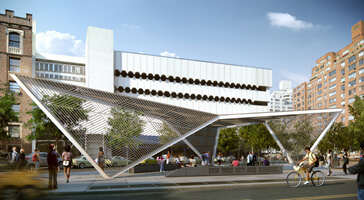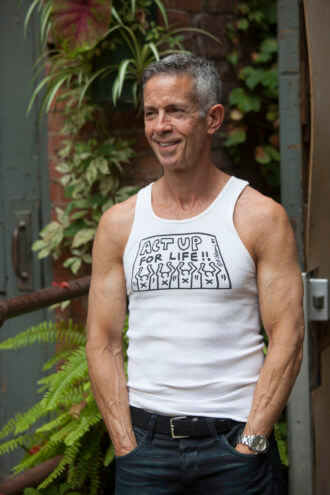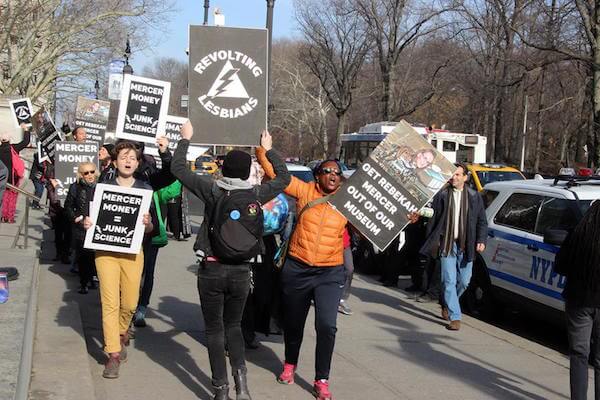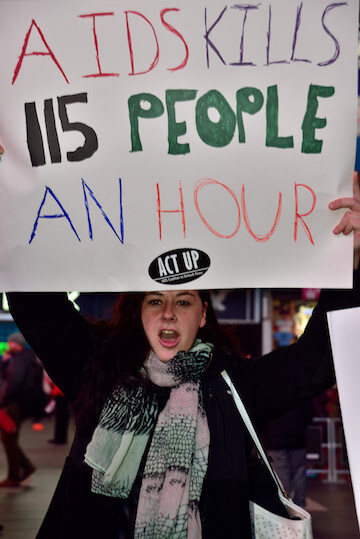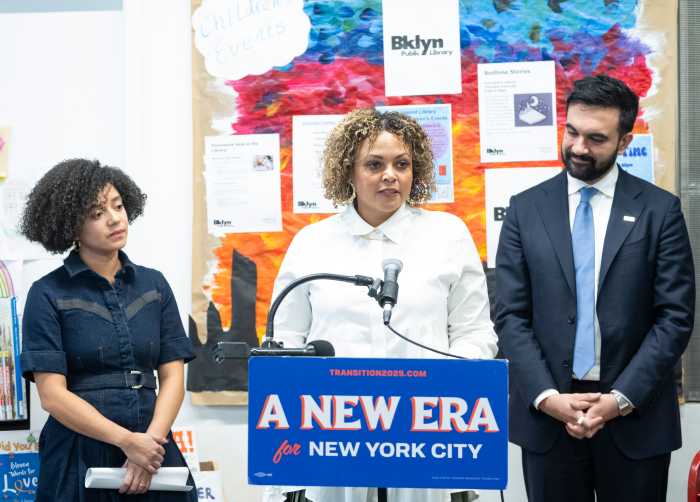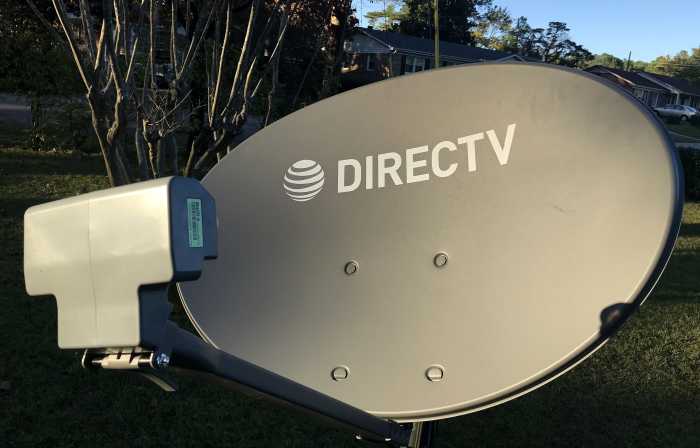A nighttime rendering of Studio a+i's design for the AIDS Memorial Park in the West Village. | NEW YORK CITY AIDS MEMORIAL
In an atmosphere of both celebration and anxiety, a capital campaign for the New York City AIDS Memorial was formally launched at a March 27 press conference, with a new rendering of the triangular park — reflecting the design’s latest tweaks — unveiled as the project’s board of directors made an appeal for funds.
With roughly $2 million in hand, the board is halfway toward its goal of paying for the project planned for a parcel of land on the former St. Vincent’s Hospital campus in the West Village.
Under the terms of an agreement with Rudin Management and Community Board 2 brokered by City Council Speaker Christine Quinn, the site preparation is the responsibility of Rudin, which is redeveloping much of the rest of the St. Vincent’s property. The cost of building that portion of a larger new park that will be dedicated to the AIDS Memorial, however, falls on the project’s sponsors. The commemoration of the epidemic’s early days and the role the West Village community and the now shuttered hospital played in responding will encompass 1,600 square feet out a parcel of 16,000 square feet being redeveloped as parkland in a triangle bounded by Seventh and Greenwich Avenues and 12th Street.
“The goal of the capital campaign is $4 million, with donations from both the private and public sectors,” said Keith Fox, president of the New York City AIDS Memorial board. “To date, we have already received $975,000 in private commitments needed to fund the design and construction of the new memorial.”
At the news conference, Manhattan Borough President Scott Stringer, a candidate this year for New York City comptroller, added $1 million in public funds, saying when it is completed, “the AIDS Memorial will be an important place of reflection for so many of us who lost loved ones and friends — and it will also be a reminder to future generations that New York City must be forever vigilant when it comes to protecting the health and well-being of our residents.”
Stringer was one of the first elected officials to publicly support the project.
A daytime rendering of Studio a+i's design for the AIDS Memorial Park in the West Village. | NEW YORK CITY AIDS MEMORIAL
The rapid progress in identifying funding was certainly cause for happiness, but the magnitude of the remaining task still provoked a sense of urgency. From an idea germinated in the heads of two young city planning professionals who never lived in a world without HIV/ AIDS to a design approved by city agencies, the AIDS Memorial is on the cusp of becoming a reality.
Praise for the role played by Quinn, a mayoral contender, and Wayne Kawadler, a policy advisor to the speaker and her point person on the project, was effusive.
“Chris’ and Wayne’s work was extraordinary in shepherding us through the government approval process, which was highly complex and challenging and which we probably would not have navigated successfully absent Speaker Quinn’s direct, hands-on intervention,” said Ethan Geto, a member of the board and a longtime public relations guru engaged in civic policy matters.
The successful push for a memorial, Fox said, began when “two doe-eyed” planners, Paul Kelterborn and Christopher Tepper, began discussing the fact that young gay men who came of age after the worst days of the epidemic had no idea that St. Vincent’s Hospital had the first AIDS ward and was the epicenter of the crisis during the dreadful years when HIV infection was a death sentence. The location of the new park, Fox and Tepper explained, has deep historical resonance. Not only is it on land formerly occupied by St. Vincent’s, but it is just a block from the LGBT Community Center, where ACT UP was born in 1987. The activism that grew up there led to the successful push for effective anti-retroviral treatments finally brought online by the mid-1990s.
Tony Kushner, the Pulitzer Prize and Tony Award-winning playwright, whose 1993 “Angels in America” stunningly evoked the existential and spiritual threat that AIDS posed for gay men across the US, will curate the text –– to be drawn from a variety of writers and activists –– that will be carved in a circular motif at ground level at the western gateway to the site. Within the circle, a round piece of granite bathed by water will provide a quiet fountain to encourage reflection.
The memorial’s steel canopy will repeat the memorial site’s triangular shape, allowing a high roof but anchoring the site at specific points on the tips of triangular supports so that the park is sheltered, but never enclosed, with the play of light and shadow in constant transformation. The site’s designer, Studio a+i, placed repeated emphasis on triangles in the canopy structure as symbolic echoes of the pink triangles slapped on gay prisoners in Nazi concentration camps during the Holocaust.
Speakers at the event praised Broadway Cares/ Equity Fights AIDS for quickly responding to an early plea for funds with a $105,000 donation that covered the ongoing costs of an architectural design competition that drew 500 submissions. Michael Arad, designer of the National September 11th Memorial, led a jury that selected the Studio a+i design. The participation of Arad and other prestigious design professionals demonstrated the wide support for an AIDS memorial at a time when its advocates were first building political support for the project.
The Arcus Foundation also made a significant contribution to the memorial effort, donating $250,000.
“So much of the progress made by the LGBT movement is owed to the incredible AIDS activists who catalyzed organizations and advocacy that continue to serve us today,” said Kevin Jennings, Arcus’ executive director. “Their story is an inspirational one of a community uniting to fight for its very life, and ensuring that this story is preserved and taught to future generations couldn't be more important.”
Quinn also spoke to the project’s historical significance.
“The New York City AIDS Memorial will help us to honor those who fought and remember those we lost during the early years of the AIDS crisis,” she said. “Its location in the West Village will remind us of the location of the original epicenter of the epidemic. I thank all who have contributed to get us to the place we are today — including the designers, city officials, local neighborhood residents, and the community board. I urge those who can to provide additional support and to remember that this memorial will connect existing generations of New Yorkers with their history and help inspire young people to become active in the ongoing fight against HIV/ AIDS, which is still ravaging so many of our communities in all five boroughs of the city.”

